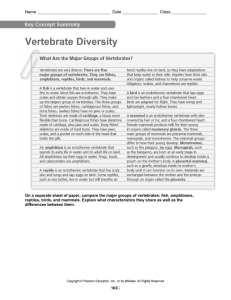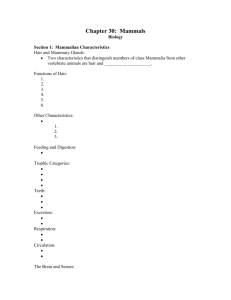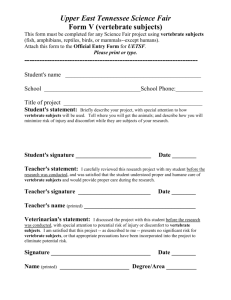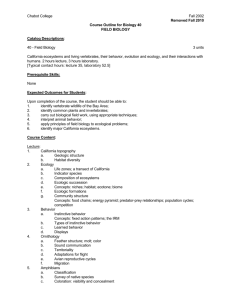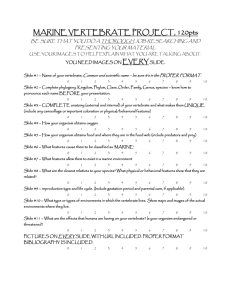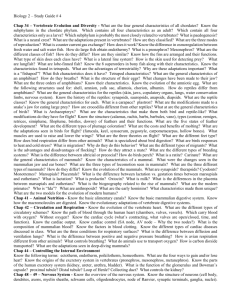Last time we covered… GY 112: Earth History UNIVERSITY OF SOUTH ALABAMA
advertisement
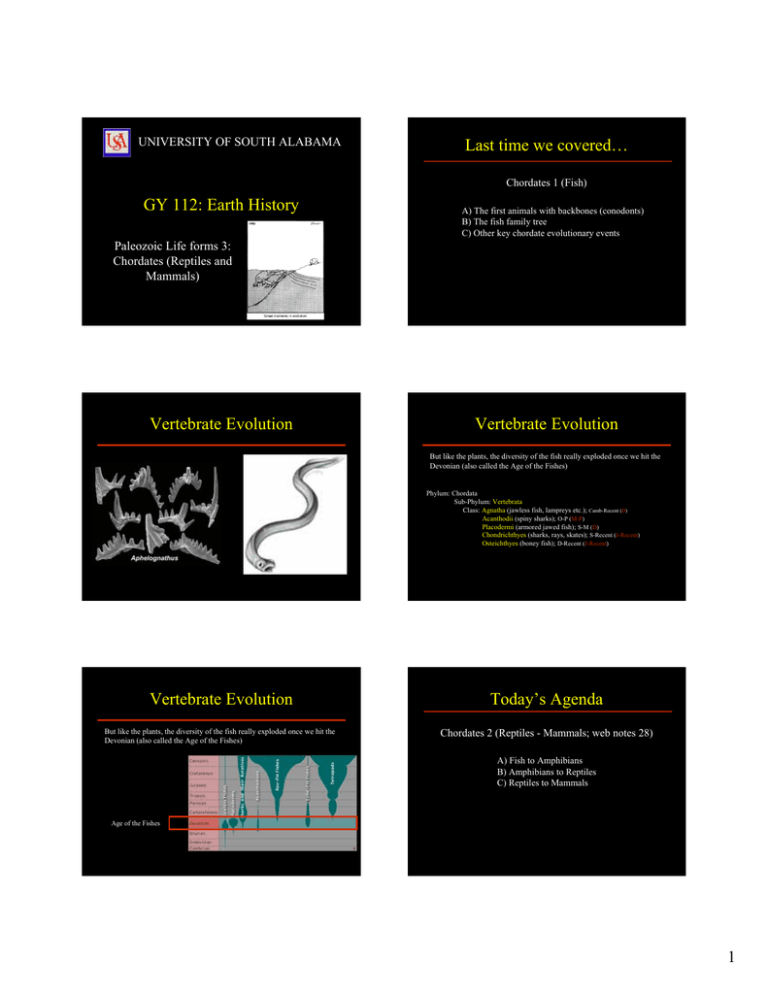
UNIVERSITY OF SOUTH ALABAMA Last time we covered… Chordates 1 (Fish) GY 112: Earth History A) The first animals with backbones (conodonts) B) The fish family tree C) Other key chordate evolutionary events Paleozoic Life forms 3: Chordates (Reptiles and Mammals) Vertebrate Evolution Vertebrate Evolution But like the plants, the diversity of the fish really exploded once we hit the Devonian (also called the Age of the Fishes) Phylum: Chordata Sub-Phylum: Vertebrata Class: Agnatha (jawless fish, lampreys etc.); Camb-Recent (D) Acanthodii (spiny sharks); O-P (M-P) Placodermi (armored jawed fish); S-M (D) Chondrichthyes (sharks, rays, skates); S-Recent (J-Recent) Osteichthyes (boney fish); D-Recent (J-Recent) Vertebrate Evolution Today’s Agenda But like the plants, the diversity of the fish really exploded once we hit the Devonian (also called the Age of the Fishes) Chordates 2 (Reptiles - Mammals; web notes 28) A) Fish to Amphibians B) Amphibians to Reptiles C) Reptiles to Mammals Age of the Fishes 1 Vertebrate Evolution Vertebrate Evolution The first “fish” to cross over on to land needed to have strong “legs”. Lobe-finned Osteichthyes Ray-finned Osteichthyes Consider the plight of fish in an increasingly hostile and dangerous place; the oceans Vertebrate Evolution The first “fish” to cross over on to land needed to have strong “legs”. But they took their life style with them (thin porous skin, reproduction by “naked” eggs laid in water). Vertebrate Evolution The first “fish” to cross over on to land needed to have strong “legs”. But they took their life style with them (thin porous skin, reproduction by “naked” eggs laid in water). Thus evolved the first amphibians (Class: Amphibia) An early tetrapod Vertebrate Evolution Vertebrate Evolution A classic missing link fossil was recently found in northern Canada (Tiktaalik roseae). It shares features of both fish and amphibians. The amphibians arose in the Devonian (Age of Plants) when there were lots of wetlands (swamps). Question: What starts to happen in the Mississippian? 2 Vertebrate Evolution Major orogenies which lead to… Vertebrate Evolution So how do you adapt? A major climate shift. It becomes cooler and drier. Vertebrate Evolution So how do you adapt? Avoid dehydrating. Vertebrate Evolution So how do you adapt? Avoid dehydrating. •Tighter waterproof skin Vertebrate Evolution So how do you adapt? Avoid dehydrating. Vertebrate Evolution Thus were born the reptiles (Class: Reptilia). •Tighter waterproof skin •Encased (amniotic) eggs http://kentsimmons.uwinnipeg.ca/16cm05/1116/34-19-AmnioticEgg-L.gif 3 Vertebrate Evolution Reptile Evolution Thus were born the reptiles (Class: Reptilia). And they did quite well on the Earth, especially during the Mesozoic (Age of the Reptiles) Reptile Evolution Reptile Evolution Quadrupeds Quadrupeds Bipeds Bipeds Archaeopteryx Ave Evolution (Triassic/Jurassic) Mammal Evolution 4 Mammal Evolution Meet one of your earliest ancestors. It evolved from a group of mammal-like reptiles (therapsids) that appeared in the Triassic. Mammal Evolution All Mammals share the following common characteristics: Mammal Evolution Thus appeared the Mammals (Class: Mammalia). They may have first evolved in the Triassic, but they didn’t take off in numbers until the start of the Cenozoic. Mammal Evolution We distinguish 3 mammalian subclasses (these are not their official names, just common names): •Fur •Mammary glands •Mostly live birth Mammal Evolution Mammal Evolution We distinguish 3 mammalian subclasses (these are not their official names, just common names): We distinguish 3 mammalian subclasses (these are not their official names, just common names): •Monotremes egg-laying mammals; first of the class to appear in the rock (Triassic) •Marsupials: live birth, but require further development time in a pouch (Mid Cretaceous) 5 Mammal Evolution Mammal Evolution We distinguish 3 mammalian subclasses (these are not their official names, just common names): •Placental mammals: live birth; young “fully” developed at birth (Late Cretaceous) http://www.on-lineretrievers.com/images2/mom_puppies.JPEG Vertebrate Evolution Today’s Homework 1. Time Chart due NOW! 2. Go see a movie with a loved one Next Time 1. The Mesozoic (Overview) 6
